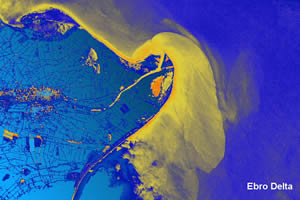Coastal case studies
Coastal zones have one of the highest population densities in the Mediterranean area. They support an unparalleled concentration of uses and infrastructure in the region. They are also vital for their high biological productivity and the link they provide between terrestrial and aquatic ecosystems. Even under present climate conditions they experience high levels of hazards since they are naturally much more dynamic than inland waters or open sea, and are in conflict with the "rigid" civil engineering structures built in coastal zones. Consequently, coastal zones constitute excellent case studies to evaluate the cross-sector impacts of climate variability and change.
Gulf of Valencia, Spain
Within the Gulf of Valencia, the Ebro Delta and Cullera Bay are examples of coastal areas vulnerable to change in environmental and climate systems. The Ebro Delta is a low-lying coastal area protecting a deltaic plain of high environmental value and intense agricultural activity. It is particularly vulnerable to sea-level rise since about half of the deltaic plain is less than 0.5 m above the mean sea level. In Cullera Bay climate change induced warming could accelerate eutrophication and further reduce water quality in this shallow bay with deleterious effects on the natural ecosystem. Sea-level rise threatens to accentuate the environmental problems through salinisation and accelerated erosion of the coastal fringe.
West Nile Delta, Egypt
The West Nile Delta region contains many natural and cultural resources but experiences serious environmental problems. These problems include insufficient institutional capacity, widespread pollution, salt-water intrusion and a lack of environmental awareness, which makes sustainable development of the region practically impossible under the prevailing conditions. The most vulnerable areas are the low-lying coastal districts of Alexandria, an area south of Port Said, and an area near the city of Suez and the Bitter lakes. These areas are highly vulnerable to the impacts of sea level rise, which would affect the availability of fresh water, agricultural and energy resources, as well as human settlements.
Gulf of Oran, Algeria
The west coast of Algeria acts as a buffer zone with Atlantic currents and oceanographic dynamics determining the spatio-temporal distribution of temperature and salinity. Rainfall in the region is extremely irregular, which in some years leaves the agricultural industry suffering from water scarcity and a substantially reduced harvest. Other environmental pressures are associated with harbour activities, the scarcity of urban waste water treatment, and concentrations of river nutrients and pollutants. The complexity of the shoreline and the magnitude of nutrient loads have induced significant problems of coastal pollution. The region has experienced periods of extreme warmth in recent years which can accelerate eutrophication and further degrade water quality.
Gulf of Gabès, southeast Tunisia
A key feature of the Gulf of Gabès is the shallowness of the basin which means that nearshore waters are very sensitive to atmospheric conditions. In summer, the particularly high temperatures and salinity lead to the appearance of red algae. This is one of the most biologically productive zones in the eastern Mediterranean and a key centre for fishing activity in Tunisia, however, the coastline suffers from problems related to toxic industrial discharge. The pollution affects an extensive part of the oceanic environment and has lead to the reduction and almost complete disappearance of several marine plant species. The Gulf also has a heightened vulnerability to sea-level rise, particularly the low-lying islands of Kerkean, Kneis and Djerba. Severe erosion of the littoral zone has already been observed and this could accelerate with sea-level rise.
Key hazards and vulnerabilities
 The fragile balance of these complex rural systems is threatened by environmental and social pressures, rendering these regions particularly vulnerable to climate change. The main climate threats for the rural case studies are related to: atmospheric warming, shifts in rainfall patterns, and extreme events (such as flood, dry spells, heat waves, storms). These climate hazards are expected to have direct negative consequences for agricultural production and the stability of natural ecosystems. In particular, a reduction in available water will have repercussions for water resource management as the competition between different sectors intensifies. There are large economic implications which may alter the characteristics of the workforce at a regional scale and the continuity of water supply to the general population.
The fragile balance of these complex rural systems is threatened by environmental and social pressures, rendering these regions particularly vulnerable to climate change. The main climate threats for the rural case studies are related to: atmospheric warming, shifts in rainfall patterns, and extreme events (such as flood, dry spells, heat waves, storms). These climate hazards are expected to have direct negative consequences for agricultural production and the stability of natural ecosystems. In particular, a reduction in available water will have repercussions for water resource management as the competition between different sectors intensifies. There are large economic implications which may alter the characteristics of the workforce at a regional scale and the continuity of water supply to the general population.
![]() Briefing notes: Overview of the coastal case studies
Briefing notes: Overview of the coastal case studies
.
 Integrating Case Studies
Integrating Case Studies